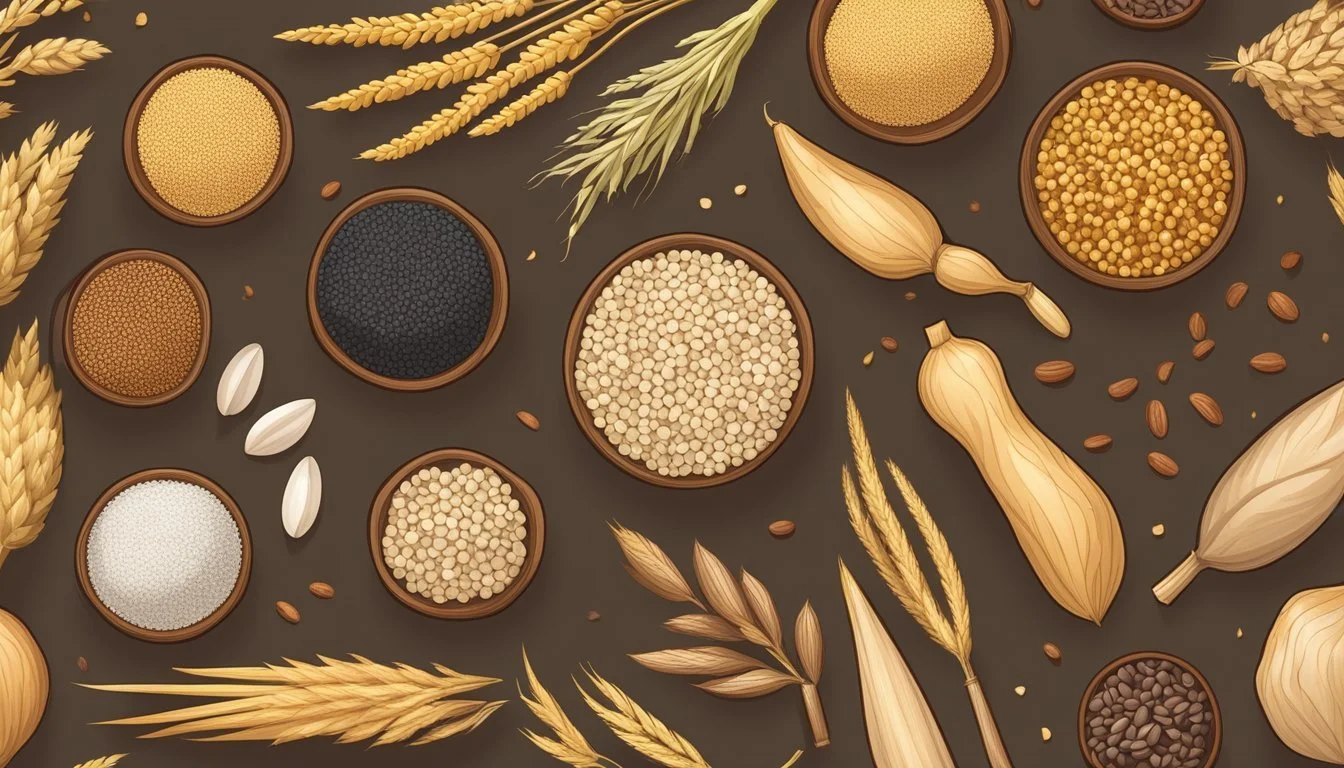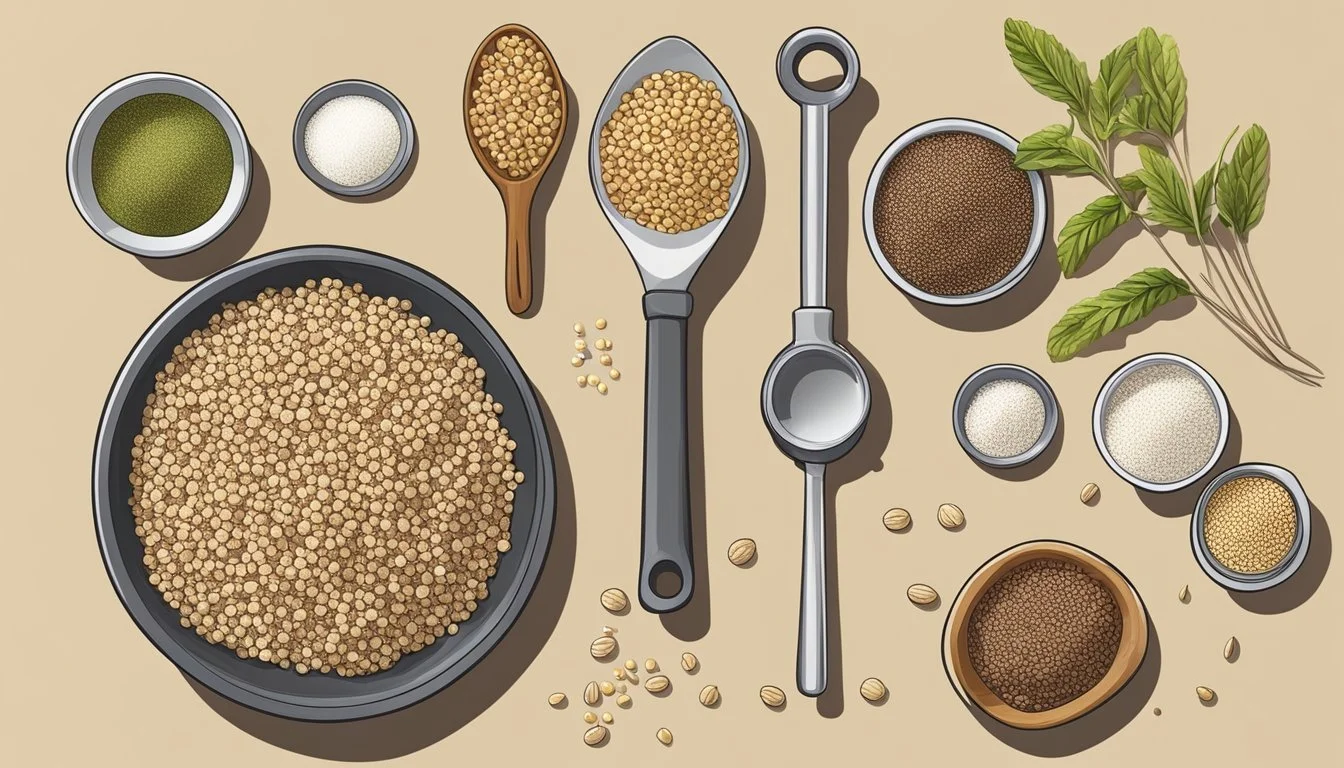Buckwheat Substitutes
Top Alternatives for Gluten-Free Cooking
Buckwheat is a highly versatile pseudo-cereal admired for its nutritional benefits and gluten-free nature. Unlike true grains, buckwheat is not a member of the grass family, which means it’s suitable for those with gluten intolerance or celiac disease. Its seeds are rich in protein and essential amino acids, making it an excellent component in a balanced diet. However, despite its advantages, some may seek alternatives due to taste preference, availability, or simply for variety in their meals.
There are several suitable substitutes for buckwheat that maintain a comparable nutritional profile and can cater to gluten-free requirements. Quinoa, for instance, stands out as a popular alternative. Like buckwheat, it is a complete protein source and gluten-free, aligning well with dietary restrictions and health-oriented cooking. Quinoa's nutty flavor and texture make it an ideal replacement in dishes ranging from porridges to salads.
Another alternative, millet, is a grain that cooks to a light and fluffy texture, lending itself well to a variety of preparations. It is often recommended as a buckwheat substitute because of its gentle flavor and its ability to absorb the tastes of other ingredients, which makes it a versatile ingredient in culinary applications where buckwheat would traditionally be used.
Understanding Buckwheat
Buckwheat is not a grain but a seed, closely related to rhubarb and sorrel, making it a suitable staple for gluten-free diets. Its small, triangular seeds are frequently processed into buckwheat flour, characterized by a distinct nutty and earthy flavor. This flour is a staple in many traditional dishes around the world, including soba noodles in Japan and blinis in Russia.
Notably, buckwheat is praised for its high nutritional value. It is a rich source of protein, providing all essential amino acids, thus considered complete. In addition to protein, buckwheat is packed with dietary fiber. The seed also delivers a substantial amount of minerals such as magnesium and manganese, both vital for bone health and metabolic function. Copper, another mineral present in buckwheat, is essential for maintaining healthy blood vessels and a strong immune system.
Buckwheat's contribution to health extends to its content of bioactive compounds. It contains various antioxidants, including rutin, tannins, and catechins. These antioxidants offer protective benefits against oxidative stress and we may associate them with reduced risk of chronic diseases.
When ground into flour, buckwheat's properties lend a unique profile to baked goods. Although buckwheat flour behaves differently than traditional wheat flour in recipes, its versatility is appreciated in gluten-free and nutrition-conscious baking.
In sum, buckwheat's strengths lie in its:
Gluten-free nature, suitable for those with gluten sensitivities
Rich, nutty and earthy taste
Abundance in protein, fiber, and essential minerals
Presence of health-promoting antioxidants
Popular Buckwheat Substitutes
When looking for buckwheat substitutes, several grains and cereals offer similar nutritional benefits and can accommodate dietary restrictions such as gluten sensitivities. Each alternative brings its own unique flavor and texture to dishes.
Quinoa
Quinoa is a high-protein, gluten-free alternative that shares a similar nutty taste to buckwheat. It's an excellent choice for those seeking a complete protein source in their meals.
Rice
Rice, specifically the brown variety, is a versatile substitute with a mild, earthy flavor. It's gluten-free and can be used in a multitude of recipes that call for buckwheat.
Oats
Oats provide a healthy, hearty alternative with a mild flavor. However, one must ensure they are labeled gluten-free to avoid cross-contamination as oats inherently do not contain gluten.
Millet
Millet has a light and fluffy texture with a mildly sweet flavor, which makes it a fitting option for both sweet and savory dishes, serving as a versatile and gluten-free buckwheat alternative.
Amaranth
Amaranth is a nutritious, gluten-free grain with a slightly sweet and nutty flavor, making it suitable for a variety of culinary uses where buckwheat is typically employed.
Barley
Barley offers a chewy texture and rich taste but is not gluten-free. This substitute is ideal in terms of flavor but should be avoided by those with gluten intolerance.
Sorghum
Sorghum is a gluten-free grain with a mild taste that can be used in recipes as a buckwheat substitute, especially in baking due to its light texture.
Spelt
Spelt provides a nutty and slightly sweet flavor similar to buckwheat but contains gluten, making it unsuitable for individuals with gluten sensitivities or celiac disease.
Chickpeas
Chickpeas, in flour form, serve as a gluten-free, protein-rich alternative to buckwheat. Their earthy flavor complements savory dishes well.
Kamut
Kamut boasts a rich, buttery flavor and is another healthy substitute for buckwheat. Note that although it's an ancient grain, Kamut does contain gluten.
Gluten-Free Alternatives
When substituting buckwheat in gluten-free baking, it's vital to select alternatives that won't compromise taste or texture. The following flours are all excellent choices for those with gluten sensitivities or celiac disease, offering versatile options for various recipes.
Quinoa Flour
Quinoa flour is made from ground quinoa. It is known for its high protein content and provides a nutty flavor to baked goods. It's an ideal choice for breads, muffins, and pancakes.
Rice Flour
Rice flour, particularly white rice flour, is a common staple in gluten-free baking due to its mild flavor. It's often used in combination with other gluten-free flours to improve texture.
Brown Rice Flour: A whole grain flour that lends a richer, nuttier flavor than its white counterpart. It's highly versatile, working well in breads, sauces, and as a thickening agent.
Sorghum Flour
Sorghum flour, made from the sorghum plant, is a staple in gluten-free recipes. Its mild taste and light color make it a desirable alternative, especially for cakes and cookies.
Oat Flour
Oat flour is created by grinding whole oats into a fine powder. It's identified by its subtle flavor and adds a chewy texture to baked goods. Ensure that the oats are certified gluten-free to avoid contamination.
Spelt Flour
Note: Spelt flour is not gluten-free and is not suitable for individuals with celiac disease or gluten intolerance.
Chickpea Flour
Chickpea flour, also known as gram or garbanzo bean flour, offers a dense and hearty texture. It's high in protein and fiber, making it a nutritious choice for breads and savory dishes.
Gluten-Free Flour Mixes
Pre-made gluten-free flour mixes can approximate the texture and properties of buckwheat flour. These mixes often contain a blend of flours like rice, potato, and tapioca, designed to simulate the results of traditional gluten-containing flours in baking.
Culinary Uses of Buckwheat Substitutes
Buckwheat's distinctive taste and texture make it a valued ingredient in kitchens, but several substitutes offer comparable benefits for different culinary applications.
Baking
Substitutes for buckwheat in baking must replicate its unique texture and the moisture it imparts. Millet serves greatly in breads, providing a light and airy structure, whereas rice flour can be a go-to for a gluten-free option, suitable for making cakes and pancakes. A critical consideration is starch content, which affects how well these substitutes bind in dough and influence the final product's tenderness.
Cooking Grains
For dishes where buckwheat is typically used as a cereal or porridge, quinoa and oats are nutritious alternatives, both rich in fiber and easy to cook. They can mimic the consistency and heartiness of buckwheat, with quinoa offering an additional complete protein source. These grains can be simmered until they reach a similar tender texture to buckwheat and are excellent in warm breakfast recipes.
Soups and Stews
In soups and stews, buckwheat adds bulk and an earthy flavor. Alternatives like amaranth can substitute buckwheat's role as a thickener due to its starch content, while adding a mildly nutty taste. Meanwhile, wild rice provides a chewy texture and complements the robust flavors often found in soups and stews.
Salads and Pilaf
Buckwheat is commonly used in salads and pilaf for its firm texture and subtle taste, which pairs well with a variety of dressings and vegetables. Brown rice can take center stage in pilafs, offering a slight chew and nutty flavor. Additionally, cornmeal can be used in some salad recipes, especially when aiming for a different texture that absorbs sauces effectively.
Texture and Flavor Considerations
When replacing buckwheat in recipes, one must be mindful of both texture and flavor differences that substitutes will impart. Buckwheat has a unique profile, characterized by a nutty and earthy flavor that adds depth to a variety of dishes. It also possesses a distinct texture that can influence the mouthfeel of the final product.
Barley Flour: It tends to impart a slightly sweet taste and a cake-like texture. Its use is ideal for creating a tender crumb in baked goods like biscuits and cookies.
Taste: Slightly sweet
Texture: Cake-like, good for biscuits
Rye Flour: Recognized for yielding dense and dark bread, rye flour contributes an intense, rich flavor. It can serve as a substitute for those seeking to replicate the earthy flavor of buckwheat.
Taste: Deep, rich
Texture: Dense, suitable for dark bread
Brown Rice Flour: Brown rice flour is known for its milder flavor and lighter texture, making it an excellent choice for those desiring a less pronounced taste.
Taste: Mild
Texture: Light, ideal for general baking
Oat Flour: The flour from finely ground oats offers a milder, nutty flavor comparable to buckwheat and boasts a moist, spongy, and soft texture. However, the gluten-free status can depend on the processing method, so buyers should ensure the oat flour is certified gluten-free if necessary.
Taste: Mild, nutty
Texture: Moist, spongy, and soft
Each alternative comes with its own set of properties affecting starch content, moisture levels, and overall mouthfeel. For example, certain flours may result in a chewier texture, while others might make baked goods more dense or light. Bakers must consider these nuances to achieve the desired outcome in their culinary creations.
Nutritional Adaptation in Recipes
When substituting buckwheat in recipes, individuals often look for options that provide comparable nutritional benefits. Buckwheat is known for its high protein, fiber, vitamins, and minerals. Substitutes should ideally align with these properties to maintain the nutritional value of the dish.
Quinoa, for example, is an excellent alternative as it contains a balanced set of amino acids and is rich in both protein and fiber. It also contributes a variety of minerals such as magnesium and iron, making it a suitable choice for those seeking a nutrient-dense diet.
Millet also stands out for its health benefits. It is gluten-free and provides fiber, which promotes digestive health. Additionally, millet offers magnesium, which is crucial for bone health and energy production.
Substitute Protein Fiber Vitamins/Minerals Quinoa High High Magnesium, Iron, B-Vitamins Millet Moderate High Magnesium, B-Vitamins
It's essential to also consider the intended use in recipes. Where a fluffy texture is desired, as in the replacement of buckwheat groats, millet can be used. For baking purposes, where the robust flavor of buckwheat is preferred, barley flour is a viable option as it provides a slightly sweet taste and nutrients like selenium.
Those not sensitive to gluten might opt for rye flour in dense bread recipes. Rye is particularly high in fiber, supporting heart and gut health.
Brown rice, often used for its benefits in a healthy diet, is another substitute for buckwheat groats. It is lower in protein but still provides essential nutrients and fiber, making it a valuable dietary component when considering nutritional adaptations.
Cooking Tips and Tricks
When substituting buckwheat in recipes, it's essential to account for differences in taste, texture, and behavior in cooking processes to achieve the desired outcome. Here are specific tips for using substitutes as thickening agents, enhancing flavors, and blending flours effectively.
Thickening Agents
Substitutes like cornmeal and rice flour are excellent thickening agents for sauces and stews. They both have a mild flavor that does not overpower the dish. The key is to mix them with a small amount of cold water to create a slurry before adding it to the hot liquid, which helps to prevent clumping. For a nutty flavor, one might opt for quinoa or amaranth as thickeners, but these will impart their distinct taste to the dish.
Cornmeal:
For a medium-thick sauce, use 1 tablespoon per cup of liquid.
Stir constantly until the desired thickness is achieved.
Rice flour:
Use 1.5 teaspoons for every cup of liquid to thicken gravies and sauces.
It has a starch content that when heated, helps in creating a smooth consistency.
Flavor Enhancements
To enhance the earthy flavor that buckwheat brings to recipes, substitutions like millet or rye flour can be used. Rye flour, specifically, gives a deep, rich taste to baked goods similar to buckwheat. When using lighter substitutes like oats or brown rice, one might consider toasting the grains or flours lightly to bring out a subtle, nutty flavor.
Millet:
Has a slightly sweet taste and fluffy texture; ideal for light and airy recipes.
Toast gently before adding to dishes to enhance its flavor profile.
Rye flour:
Known for its dense texture and robust flavor.
Add in small amounts to prevent overpowering other flavors in the recipe.
Mixing and Blending Flours
In baking, no single flour substitute provides the exact qualities of buckwheat. Thus, it can be beneficial to blend different flours for a balance of flavor and texture. For example, mixing oat flour with brown rice flour can provide both the lightness and the binding quality needed in dough. For those with sensitivities, ancient grains like amaranth and sorghum are gluten-free options that also contribute a desirable texture to baked goods.
Blend for texture:
Combine oat flour with starch-rich flours like brown rice flour for improved structure in baked goods.
A ratio of 1:1 often works well, but one should adjust based on the specific recipe and desired outcome.
Consider sensitivities:
Gluten-free options like quinoa and amaranth are suitable for those with gluten intolerances.
Always ensure water ratios and cooking times are adjusted as these flours absorb liquid and cook differently than buckwheat.
Buckwheat in Different Cultures
Buckwheat serves as a staple in many cultural dishes around the world, from the soba noodles of Japan to the hearty kasha meals of Slavic regions.
Asia and Soba Noodles
In Asia, particularly Japan, buckwheat is prominently featured in the form of soba noodles. These noodles are made from buckwheat flour, providing a unique, nutty flavor and a firm texture that is highly valued in Asian cuisine. Soba noodles are traditionally served both chilled with a dipping sauce and in hot broth as nourishing soups.
Slavic Cuisines and Kasha
Moving to Eastern Europe, especially in Slavic cultures, buckwheat takes the form of kasha. Kasha refers to buckwheat groats that have been roasted to bring out a deeper flavor. It's a common comfort food and is usually prepared by cooking the groats in boiling water or milk, often served with onions, mushrooms, or meats. Kasha is appreciated for its nutritional value and satiating qualities in Slavic diets.
Health Considerations
When selecting buckwheat substitutes, one must assess their health impact, particularly for individuals with specific dietary needs. Each alternative brings a distinct nutritional profile catering to different health requirements.
Allergies: For those with buckwheat allergies, alternatives like millet, quinoa, and oats provide safe options. It's crucial to ensure the substitute doesn't trigger other allergies and maintains the balance of nutrients.
Gluten Sensitivities and Celiac Disease: Gluten-free options are vital for individuals with gluten intolerance or celiac disease. Quinoa is a gluten-free grain, known for its comparable nutty flavor to buckwheat and its rich nutrient profile. Similarly, brown rice flour offers a gluten-free solution with the added benefit of a high fiber content, supporting digestive wellness.
Substitute Gluten-Free High Protein Quinoa Yes Yes Millet Yes Moderate Brown Rice Yes Low Oats Yes* Moderate
*Oats are naturally gluten-free but can be contaminated with gluten during processing, so one should look for certified gluten-free oats.
Nutrition: In terms of nutrition, these substitutes often match or exceed the nutrients found in buckwheat, particularly in high protein content. Quinoa, for instance, is well-regarded for its high protein quality, essential amino acids, and fiber.
When integrating substitutes into a diet, it's vital for one to consider their overall nutritional goals. Each grain possesses a unique combination of nutrients, making some better suited for specific health needs than others. The choice of an adequate substitute must align with one's health objectives, ensuring the maintenance of a healthy and balanced diet.
Navigating the Market for Substitutes
When looking for alternatives to buckwheat, consumers have several options available in the market. Each substitute brings its own unique qualities to the table, and understanding these can guide shoppers in making an informed decision.
Quinoa and amaranth stand out as gluten-free options, making them suitable for those with gluten sensitivities or celiac disease. Quinoa is recognized for its high protein and fiber content, offering a healthy alternative with a similar nutty flavor and texture to buckwheat.
Millet and cornmeal are praised for their light textures. Millet, in particular, fluffs up when cooked, which can closely mimic the feel of buckwheat groats in dishes.
Substitute Gluten-Free Protein-Rich Best Used In Quinoa Yes Yes Salads, soups Millet No Moderate Porridge, side dishes Amaranth Yes Yes Baked goods, cereals Cornmeal No Low Pancakes, breading Barley Flour No Low Biscuits, cookies Rye Flour No Moderate Bread, dense baked goods Brown Rice Yes Low Stir-fries, sushi rolls
For those who do not require gluten-free alternatives and are looking for a whole-grain option, barley flour and rye flour may be suitable substitutes in baking. Barley flour brings a slightly sweet taste and cake-like texture, while rye flour imparts a deep, rich flavor.
Consumers interested in using brown rice can find it a versatile buckwheat substitute in a variety of recipes, from stir-fries to sushi rolls, without compromising on health benefits.
Shoppers should consider their dietary needs and cooking intentions when selecting a buckwheat substitute. The market provides a range of alternatives to fit various preferences and recipes, ensuring there's a suitable choice for everyone.
Recipe Adaptations and Substitutions
When substituting buckwheat in recipes, one must consider both texture and flavor. Buckwheat flour, known for its unique taste and gluten-free properties, plays a crucial role in a variety of dishes ranging from pancakes to noodles.
For baking, alternatives such as barley flour can be used, imparting a slightly sweet taste and a cake-like texture. Barley flour is especially suitable for baked goods like biscuits and cookies. Alternatively, rye flour, recognized for creating dense bread, offers a rich flavor that closely mimics that of buckwheat.
In recipes calling for buckwheat groats, such as breakfast dishes or grain-based sides, millet serves as an excellent replacement. It's light and fluffy, similar to cooked buckwheat. Here's a simple conversion chart for replacing buckwheat with two common substitutes in various dishes:
Buckwheat Barley Flour Millet 1 cup 1 cup 1 cup
For sauces and dishes where buckwheat is used as a thickening agent, one can utilize rice flour as a replacement, keeping in mind its milder flavor and lighter texture. When making pancakes or muffins, where buckwheat's distinctive taste is essential, choosing a substitute requires careful consideration to maintain the desired outcome.
Oat flour is another viable substitute for buckwheat flour. It offers a whole-grain nutrition profile and is suitable for gluten-free diets, although the texture it lends to the final product may differ.
Lastly, in noodle recipes, one should select substitutes like wheat flour, keeping in mind the textural differences. Achieving the elasticity and bite of buckwheat noodles may require a blend of flours.
Conclusion and Summary
In the culinary world, buckwheat is esteemed for its unique nutty and earthy flavors, adding distinct character to various recipes. However, availability issues or dietary restrictions necessitate the exploration of suitable substitutes. Notably, several alternatives offer comparable textures and taste profiles, while also providing a spectrum of nutritional benefits.
Table of Substitutes and Their Characteristics:
Substitute Flavor Profile Best Used In Gluten-Free Nutritional Value Barley Flour Slightly sweet, cake-like Baking biscuits, cookies No High in fiber, vitamins Rye Flour Deep, rich Dense, dark bread No Good source of fiber Millet Light, fluffy Various dishes Yes Rich in nutrients, vitamins Quinoa Slight nuttiness Various dishes Yes Protein-rich, full of amino acids
When adapting recipes, those seeking gluten-free options should consider millet or quinoa—both of which deliver a light texture and are packed with vitamins, minerals, and, in quinoa's case, complete proteins. Although barley and rye flours are not gluten-free, they can be used by those without gluten sensitivities, offering a similar taste to buckwheat.
In conclusion, the substitutes for buckwheat are numerous, and they cater to a range of dietary requirements while maintaining the integrity of recipes. Nutritional considerations and flavor should guide the selection of an alternative, ensuring both a healthful and flavorful result. Whether incorporated into gluten-free diets or used as a simple replacement, these alternatives ensure that one can continue to enjoy their favorite dishes without buckwheat.









